We have another short week, a government shutdown as partisan lines are redrawn, and also some important new data. Many will plan to take the week off, but some will be making last-minute position adjustments on Monday. I expect many market participants to happily turn the calendar page, enjoying a blank slate for the New Year.
Last Week Recap
In my last edition of WTWA, I made some suggestions about planning for uncharted waters. That was more important than I could have known. Few have charts for the market moves we saw. Even the punditry struggled to find anything substantive beyond murmuring “oversold” and “short-covering.”
My thoughts? The moves continued to involve all sectors and stocks. It was definitely not a time for short-term stock pickers. This was true on the downside in recent weeks and also accurate for last week’s rallies. Thursday’s spectacular last-hour move was fascinating. Most observers just expressed amazement. Program trades from any source can generate big moves in a thin trading environment. We had some orders working above the market and were amazed when we got filled.
CNBC’s Bob Pisani offered an explanation the next morning: Portfolio rebalancing by a big fund. In this type of trade, the fund buys stocks and sells bonds. Here is his evidence, a synchronized move of stocks and bonds.
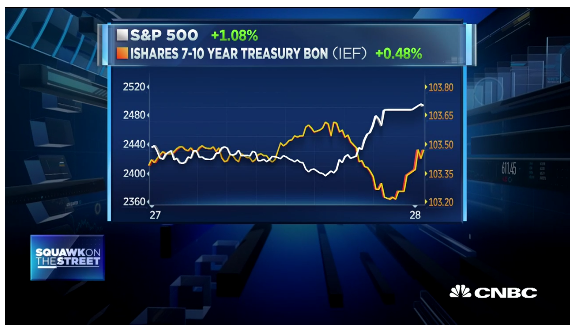
This was an 800-point Dow move in an hour or so. One fund, unless we think a number got together to trade at this time. I expect similar decisions from various pension funds and balanced funds. I did not think it would happen until investment committees met, probably in another week or so. These participants are not traders. Organizational decision making can be slow. We can expect to see more support from these sources in early January.
In an effort to provide some mid-week enlightenment, I wrote The Trepidation Trap.
Alan Steel provided another helpful view from across the pond. Read the entire post the fun and all of the key points. He included this chart followed by his own interpretation.
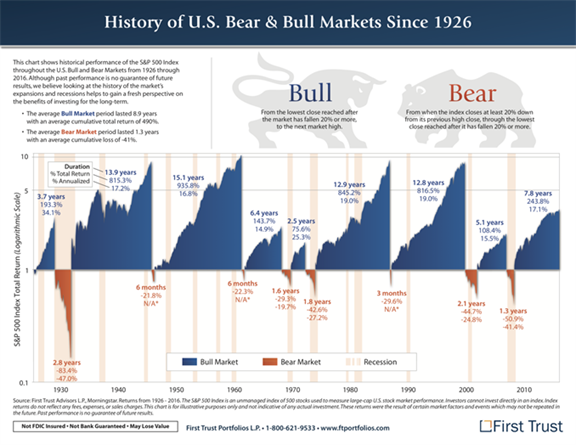
Admittedly, it’s easy to get caught up in it, particularly when the lunatics are running the asylum with:
- Algorithms (millions of little robots that make investment decisions based on market reports) that change price direction based on the same perspectiveless information we see in the headlines
- Biased and commercially driven reporting that help drive the decisions of all those little robots
- Politicians in charge of project managing a separation between the UK and European Union who have no such experience or qualifications to do so
- A megalomania-afflicted White House surrounded by a Washington DC-sized swamp of self-interest
- The usual geopolitical examples of the unconcerned, unrelenting and unhinged
Little wonder then that the consensus of opinion of investors about the stock markets are breaking negative sentiment records.
And that’s why wealth tends to avoid crowds.
The Story in One Chart
I always start my personal review of the week by looking at a great chart. This week I am featuring Jill Mislinski. She includes a lot of relevant information in a single picture – worth more than a thousand words. Read the full post for more great charts and background analysis.
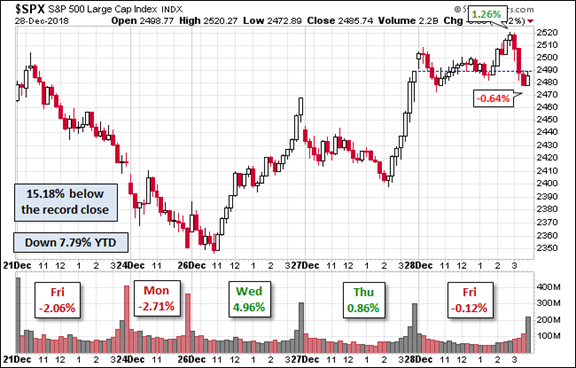
Jill’s title calls the 2.86% gain for the week a “slight bounce.” This is true in the context of the overall decline and recent volatility. The trading range for the week was 7.4%. Our indicator snapshot (below) tracks actual and implied volatility over various time frames.
The Week Ahead
We would all like to know the direction of the market in advance. Good luck with that! Second best is planning what to look for and how to react.
The Calendar
The calendar is a big one, and we have a holiday-shortened week. I am especially interested in employment – both ADP and the official BLS version. ISM manufacturing is the most important of the various PMI-style indexes. Auto sales are also important, and FedSpeak will be back in vogue.
And of course, expect plenty of noise about the government shutdown and who should be held accountable. Economic news has not made much difference in recent months, but eventually, this will change.
Briefing.com has a good U.S. economic calendar for the week. Here are the main U.S. releases.
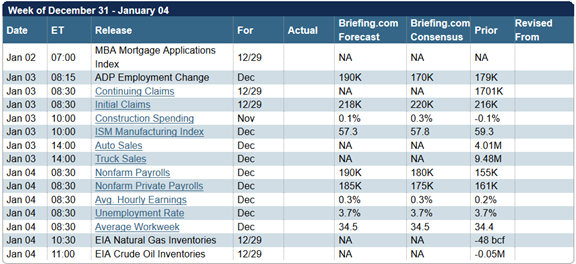
Next Week’s Theme
Last week I said that I was planning a break from WTWA today, but I decided to follow a different idea. I am going to use the “blank slate” concept to highlight some things I am observing as well as some personal conclusions. Each of these might be developed into a full post outside the WTWA context, but the ideas are timely right now.
Here are some things on my mind. Comments and other ideas are most welcome. I hope you find them interesting.
- Most of what I see and read consists of those who begin with a position and then search for evidence. They will always find some anecdote or indicator that “proves” their point. There are hundreds of possibilities. This seems especially true for those who have absolutely no experience or track record in studying recessions and now have discovered some magical indicator that we should worry about.
- There is always a peak and always a trough. Identifying these in advance is not as easy as various charts suggest. They highlight past peaks and then claim similarity.
- I don’t care if this is an official bear market as measured by a 20% decline.
- I don’t care what the P/E was in 1871. Or 1901 or even 1971. Determining relevant data is more important then using all of the data you can find.
- The past is easy to see. The present can be seen but may be difficult to interpret. The future is murky. The payoff for getting something right about the future is huge. You need not be perfect; a little edge is good enough.
- We have no idea what the jobs of the future will be. Who could have thought that playing video games could be a lucrative career? Skill in medical testing is in demand, as are many similar fields. It is easy to see layoffs and difficult to see job creation.
- Don’t you think that biotech will continue to make life-saving advances. I especially like CAR T-cell therapy. I don’t really care that politicians rant about drug prices for their own advantage, lowering the price of my good stocks in the sector. These new products are coming, and there will be big biotech winners.
- Similarly, the Internet of Things and artificial intelligence will change the world in ways that we cannot imagine. It is a good idea to own some stocks that will benefit. You don’t need to forecast specifics. Just knowing the trend is enough.
- I don’t care about what happened after the last handful of 4% single-day gains in stocks. (Or similar micro-studies). If there were hundreds of cases in a relevant time frame, you might do a good statistical study. With a handful it is better to do a careful case study. There is an appetite to see a data summary of a few cases, and thanks to computer power these are easy to generate. (And useless to read).
- And while I am thinking about that – I suspect that modern technology has made things worse for individual investors. Bad analysis is easy to create. Social networking highlights a brief comment or two and attracts trolls. Podcasts are a nice alternative but are time-consuming when compared to reading.
- I don’t care about CNBC’s “Street Cred.” Many people get a job at a big-name firm and either leave or rise to a level of incompetence.
- I don’t care about those who go on TV and tell me their interpretation of yesterday’s news. I can read the newspaper if that is interesting.
- The firehose of information has made it difficult to find relevant, objective information and analysis.
- Much of what is chosen for you to read is selected by very young, very inexperienced editors who do not have technical skills.
- Financial incentives favor sensational positions – both for writers and publishers.
- Today’s self-publishing and social networking makes it nearly impossible to correct anything – even flat-out errors. I have tried several different polite methods to no avail. You cannot reach the right audience yourself and no self-professed expert/author wants to admit a mistake. My list includes several of the most-quoted sources.
- Partly as a result of widespread errors, silly conclusions become part of the conventional wisdom.
- This makes it important to identify experts, something of a lost art.
- I don’t value opinions from those who disparage skills they do not have and never learned about.
- I don’t care what a billionaire tells me I should do with my money. You can find a billionaire saying almost anything.
- I don’t care about people whose only accomplishment is predicting something like the market decline in 2008. It is easy to ask them what they think now. Instead of finding someone’s broken clock that worked that day, tell me their entire prediction history. Look at similar prognosticators who were wrong. Find people whose methods make intellectual sense over varying market conditions. Seek skill rather than luck.
- Do the same when highlighting erroneous predictions. Finding many of these proves nothing unless you also track successes.
- Investment success involves skill. Mauboussin’s test is whether you can lose on purpose. There are many ways to do that!
- In politics, solutions and compromises are (eventually) reached when there is win-win potential.
- In free market economics, idle resources are (eventually) put to use.
- Long-term investors should embrace volatility, using it to add to positions in strong companies. Take six minutes to listen to this CNBC segment with a top value manager David Herro. Listen to the very end. Regular WTWA readers will find some familiar ideas.
Quant Corner
We follow some regularly featured sources and the best other quant news from the week.
Risk Analysis
I have a rule for my investment clients. Think first about your risk. Only then should you consider possible rewards. I monitor many quantitative reports and highlight the best methods in this weekly update.
The Indicator Snapshot
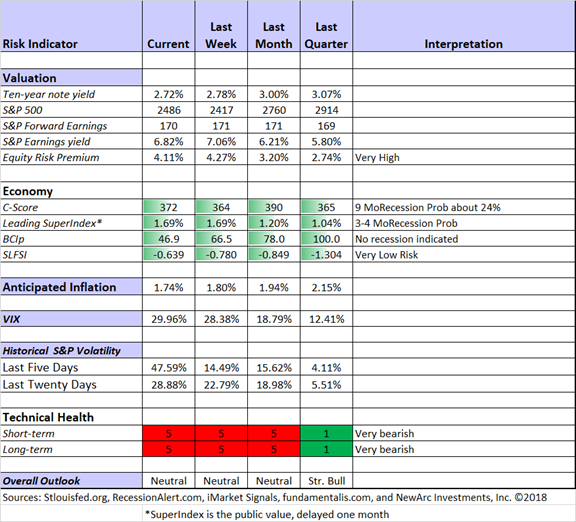
Short-term trading conditions remain at the highest risk level. This reflects Vince’s research on the combination of factors that make successful trading difficult. It does not necessarily mean that markets will move lower, but the danger is there. As I have noted in this section over recent months, we might get a full exit signal for trading models. Last week that happened for three of the trading systems.
Long-term trading also remains at the highest risk level. Those who emphasize technical analysis have emphasized the “damage” done to charts by the sustained correction. Our methods show that a clean bill of technical health will require some time.
Fundamental analysis remains strongly bullish. Earnings are great, prices are lower, and there is even less competition from bonds. We reduce fundamental positions (as we did in 2011) when we get a warning from the recession or financial stress indicators, not merely as a reaction to technical signals.
The C-Score method started showing higher recession probabilities in 2006. In early 2007 it showed that a recession was likely within the next nine months. The yield curve is part of the method, but it also includes indications for the likelihood of Fed action. It is an improvement over the yield curve by itself.
The St. Louis Financial Stress Index is not about recessions. It includes eighteen factors including various interest rates, credit spreads, the VIX, and similar factors. This research exhibits the higest statistical standards. Here is the historical chart and the suggestions for interpretation.
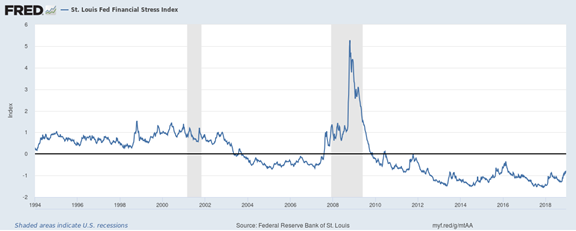
How to Interpret the Index:
The average value of the index, which begins in late 1993, is designed to be zero. Thus, zero is viewed as representing normal financial market conditions. Values below zero suggest below-average financial market stress, while values above zero suggest above-average financial market stress.
This leads me to a “neutral” overall outlook. It might be better stated as bullish for long-term investors and dangerous for short-term traders.
Final Thought
I hope readers find today’s change of pace a useful way to focus their own thinking. I am working on my “official” 2019 preview article, but some of these themes will find a home there. Others will get more attention in the year ahead.
I encourage you to think five or ten years ahead. What social and economic trends will continue? What companies will benefit?
Most of what we hear and read has a very short-term orientation. Investors need to get past this trap.
[If you are interested in finding inexpensive stocks with great potential, I hope this is helpful. We all want to have the holdings that will respond best in a rebound. Feel free to request some of my papers for individual investors. Just send an email to main at newarc dot com]
